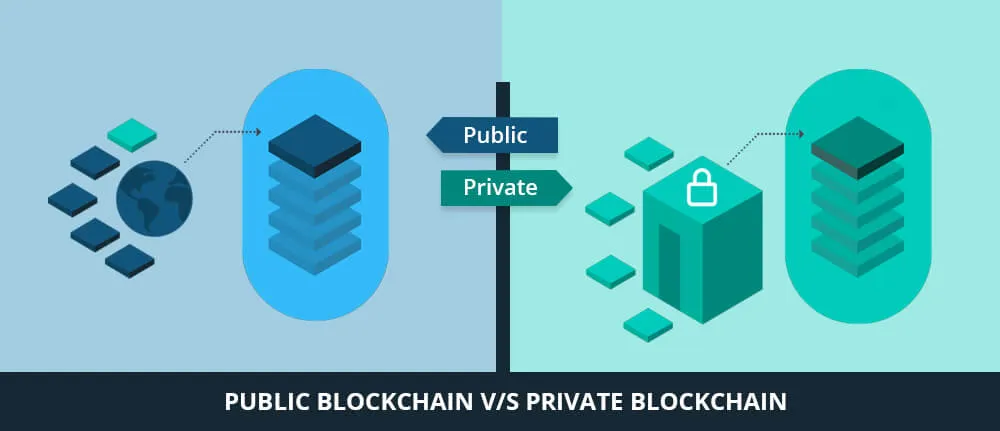Public vs Private blockchain: Which is better?
According to Fortune Business Insights, the global blockchain industry is projected to grow at a CAGR of 56.3% from $7.18 billion in 2022 to $163.83 billion by 2029. This growth is being driven by the increasing adoption of blockchain technology by businesses of all sizes and in all industries.
Blockchain technology has the potential to revolutionize many industries by providing a secure, transparent, and efficient way to record and manage data. For example, blockchain technology is being used to streamline payments, reduce fraud, improve supply chain management, and manage digital identities. As blockchain technology continues to develop and mature, we can expect to see even more innovative and groundbreaking applications for this powerful new technology.
The public vs. private blockchain debate has been ongoing since the advent of blockchain technology. In a business context, understanding the core differences between these two types is crucial. Public and private blockchains play a pivotal role in helping businesses determine the most appropriate blockchain solution for their specific needs.
Choosing the wrong blockchain platform can result in your solution’s failure. However, many people still find it confusing to differentiate between these two types. To address this, we’ll delve into the comparison of public and private blockchains in a simplified manner to provide you with clarity. Once you comprehend both their similarities and differences, you’ll be better prepared to select the one that aligns most effectively with your requirements.
Public Blockchain
A public blockchain is an open network accessible to anyone, exemplified by Ethereum. These platforms are fully decentralized but may present challenges when integrating with enterprise blockchain processes. Public blockchains, with Bitcoin as their precursor, have paved the way for blockchain technology. Their defining trait is the equal rights they provide to all participants. This inclusivity enables participation in consensus and transactions among peers while maintaining a high level of security and transparency.
Public blockchains come with their drawbacks, including slower performance and the potential to attract malicious users engaging in illegal activities due to their anonymous nature. To make an informed choice between public and private blockchains, it’s essential to understand the other side of blockchain (Private blockchain).
Private Blockchain
Private blockchains are like exclusive clubs, accessible only to a select few individuals or organizations. Think of them as private databases where transactions can be changed or erased. These networks are under the control of a central authority or a specific group, and they keep transaction details hidden from the participants. Typically, private blockchains are used by financial institutions to manage their assets within their own network. Although valuable for specific purposes, generally offer more incremental changes when compared to the revolutionary potential of public blockchains.
Public vs Private Blockchain
It’s important to know the difference between public and private blockchains in order to make informed decisions about how to use this powerful new technology. We are going to share some informative differences of public and private blockchains discussed below:
| Public Blockchain | Private Blockchain
|
|
| Access Control | Permissionless | Permissioned
|
| Transparency | All transactions are public | Transactions are only visible to authorized users
|
| Security | Prioritizes security through decentralization and cryptographic methods. | Depend on central authority.
|
| Consensus Mechanism | Proof-of-Work (PoW) or Proof-of-Stake (PoS) mechanisms. | Centralized consensus mechanisms.
|
| Scalability | Less scalable | More scalable
|
| Data handling | Full | Partial
|
| Costs | Costly due to transaction fees, mining, and maintenance. | Lower transaction costs and reduced maintenance.
|
| Interoperability | Limited | Specific
|
| Efficiency | Low | High
|
| Regulatory Compliance | Have regulatory implications | Suitable for strict regulations.
|
| Community and Support | Active communities and abundant resources for development and support. | Limited community support
|
| Use Cases | cryptocurrencies and decentralized finance. | Supply chain management.
|
| Examples | Ethereum, Bitcoin | Hyperledger Fabric, Corda |
Which is better?
According to our findings, public blockchain is better than private blockchain, Public blockchains serve as the primary source of digital assets, including Bitcoin, Ethereum, altcoins, stablecoins, DAOs, NFTs, and security tokens. Interoperability, a crucial aspect of blockchain technology, is achieved on public blockchains. The blockchain’s value hinges on its ability to integrate with DeFi technologies, enabling innovations like IX Swap, the world’s first automated security token market maker. Public blockchains are prized for their transparency and security, underpinned by decentralization. Their democratic and inclusive nature allows anyone to participate and validate transactions. Moreover, public blockchains attract top-tier developers and entrepreneurs, driving innovation and new application development. What do you think now?
Which type of blockchain is right for you?
As we explain all aspects of both types of blockchains but beyond that we want you to say, it will depend on your specific needs. If you need a blockchain that is highly transparent and secure, you can opt for a public blockchain. If you need a blockchain that is more private and efficient, you can choose a private blockchain.
